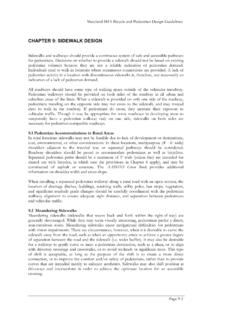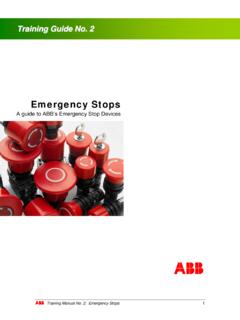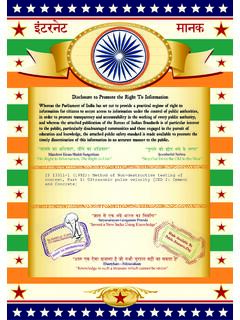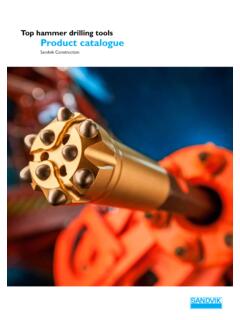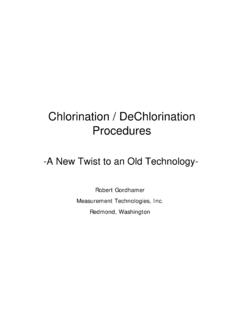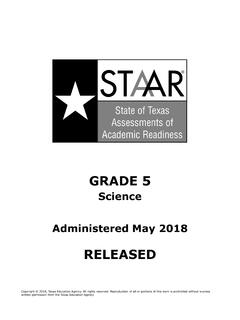Transcription of Standard Penetration Test (SPT) Correction
1 Parris N. Glendening Governor Maryland Department of Transportation John D. Porcari State Highway Administration Secretary Parker F. Williams Administrator RESEARCH REPORT. Standard Penetration TEST (SPT) Correction . BY. M. SHERIF AGGOUR AND W. ROSE RADDING. THE BRIDGE ENGINEERING SOFTWARE AND TECHNOLOGY (BEST) CENTER. DEPARTMENT OF CIVIL AND ENVIRONMENTAL ENGINEERING. UNIVERSITY OF MARYLAND. COLLEGE PARK, MD 20742. SP007B48. FINAL REPORT. SEPTEMBER 2001. The contents of this report reflect the views of the author who is responsible for the facts and the accuracy of the data presented herein.
2 The contents do not necessarily reflect the official views or policies of the Maryland State Highway Administration. This report does not constitute a Standard , specification, or regulation. Standard Penetration TEST (SPT) Correction . Report Submitted to Maryland State Highway Administration Office of Policy and Research Contract No: SP007B48. by M. Sherif Aggour and W. Rose Radding Civil and Environmental Engineering Department University of Maryland College Park, Maryland 20742. September 2001. Technical Report Documentation Page 1.
3 Report No. 2. Government Accession No. 3. Recipient's Catalog No. MD02-007B48. 4. Title and Subtitle 5. Report Date September 30, 2001. Standard Penetration TEST (SPT) Correction . 6. Performing Organization Code 7. Author/s 8. Performing Organization Report No. Aggour and W. Rose Radding 9. Performing Organization Name and Address 10. Work Unit No. (TRAIS). 11. Contract or Grant No. University of Maryland Department of Civil and Environmental Engineering College Park, MD 20742-3021. 12. Sponsoring Organization Name and Address 13.
4 Type of Report and Period Covered Maryland State Highway Administration 14. Sponsoring Agency Code Office of Policy & Research 707 N. Calvert Street Baltimore, Maryland 21202. 15. Supplementary Notes 16. Abstract The Standard Penetration Test (SPT) is currently the most popular in-situ test in obtaining subsurface information. Although great effort has been put into standardizing the SPT procedure, variability is inherent in present procedures. Research has shown that the most significant factor affecting the measured N values is the amount of energy delivered to the drill rods.
5 In order to reduce the significant variability of the SPT. N-values due to the large variation in energy delivered, it has been recommended that the N value be standardized to a specific energy level through the use of Correction factors. The purpose of this research is to summarize all available Correction factors and, with the guidance of a limited field-testing program, determine the most appropriate Correction factor. This report documents a field testing program in which energy delivered by three different hammer systems, one donut, one safety, and one automatic were measured.
6 The resulting data are presented as well as conclusions regarding the determinations and use of Correction factors in correcting the SPT N-value. 17. Key Words 18. Distribution Statement Standard Penetration test (SPT), No restrictions. hammer type, energy measurement 19. Security Classification (of this report) 20. Security Classification (of this page) 21. No. Of Pages 22. Price Unclassified Unclassified 87. Form DOT F (8-72) Reproduction of form and completed page is authorized. TABLE OF CONTENTS. Page iii ACKNOWLEDGEMENTS.
7 V LIST OF TABLES .. vi LIST OF FIGURES .. vii CHAPTERS. I. INTRODUCTION .. 1-1. General Overview .. 1-1. Objective of the 1-2. Organization of the 1-3. II. REVIEW OF LITERATURE .. 2-1. History of SPT .. 2-1. Procedures Affecting the N Values .. 2-1. Main Factor Affecting the N Values .. 2-1. SPT hammer 2-4. Recent Energy 2-5. State of 2-5. State of Oregon .. 2-5. State of Minnesota .. 2-6. tests in Maryland .. 2-6. State of 2-7. 2-8. Standard 2-8. Correction 2-11. III. ENERGY MEASURING SYSTEM .. 3-1. SPT Analyzer .. 3-1.
8 Rod and 3-1. Hand-held 3-2. Energy Measurement Methods .. 3-2. IV. FIELD TESTING PROGRAM .. 4-1. Testing Location .. 4-1. Testing Procedure and Equipment Used .. 4-1. V. DATA 5-1. Data Quality Assessment .. 5-1. Data 5-6. Correction Factors Based On Field Data .. 5-10. VI. CONCLUSIONS & 6-1. i Conclusions .. 6-1. Recommendation .. 6-3. For Immediate 6-3. Future Action .. 6-3. REFERENCES .. 7-1. APPENDICES. APPENDIX A. Boring Logs .. A-1. APPENDIX B. Field Energy APPENDIX C. Photos from the Field C-1. ii SUMMARY. The Standard Penetration Test (SPT) is currently the most popular and economical means to obtain subsurface information.
9 Although great effort has been put into standardizing the SPT. procedure, variability is inherent in present procedures. The Standard Penetration resistance is, in fact, conventionally measured using different kinds of hammers, drill rig types, drill rod lengths, drill rod types, hammer blow rates, different energy delivery systems with different degrees of efficiency, different borehole fluids, and different kinds of sampling tubes. Thus the test is performed by different equipment and testing procedures as well as different operators.
10 Consequently, the consistency of the SPT N values is questioned, , the ability of the test to reproduce blow counts using different rig systems under the same site/soil conditions. The direct impact of this inconsistency on geotechnical design quality and cost has sparked significant research on the factors that affect the N values. Research has shown that the most significant factor affecting the measured N values is the amount of energy delivered to the drill rods. Field testing indicated that the energy delivered to the rods during an SPT test can vary from 30 to 90% of the theoretical maximum, depending on the type of hammer system used.




